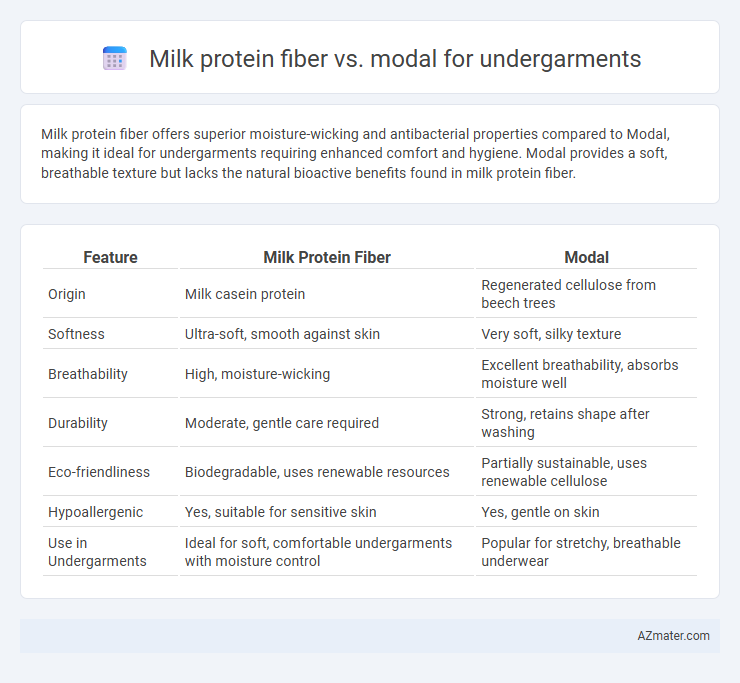Milk protein fiber offers superior moisture-wicking and antibacterial properties compared to Modal, making it ideal for undergarments requiring enhanced comfort and hygiene. Modal provides a soft, breathable texture but lacks the natural bioactive benefits found in milk protein fiber.
Table of Comparison
| Feature | Milk Protein Fiber | Modal |
|---|---|---|
| Origin | Milk casein protein | Regenerated cellulose from beech trees |
| Softness | Ultra-soft, smooth against skin | Very soft, silky texture |
| Breathability | High, moisture-wicking | Excellent breathability, absorbs moisture well |
| Durability | Moderate, gentle care required | Strong, retains shape after washing |
| Eco-friendliness | Biodegradable, uses renewable resources | Partially sustainable, uses renewable cellulose |
| Hypoallergenic | Yes, suitable for sensitive skin | Yes, gentle on skin |
| Use in Undergarments | Ideal for soft, comfortable undergarments with moisture control | Popular for stretchy, breathable underwear |
Introduction to Alternative Undergarment Fabrics
Milk protein fiber offers exceptional softness, moisture-wicking properties, and antibacterial benefits, making it an innovative choice for undergarments aimed at comfort and skin health. Modal, derived from beech tree cellulose, boasts superior breathability, durability, and a silky texture that retains shape and color after multiple washes. Both fibers serve as sustainable, skin-friendly alternatives to traditional cotton and synthetic materials, appealing to eco-conscious consumers seeking luxurious and functional undergarment fabrics.
What is Milk Protein Fiber?
Milk protein fiber is a cellulose-based fiber infused with casein protein derived from milk, offering a soft, breathable, and moisture-wicking fabric ideal for undergarments. It boasts natural antibacterial properties and biodegradability, enhancing comfort and sustainability compared to modal, which is a semi-synthetic fiber made from beech tree cellulose known for its smooth texture and high durability. Milk protein fiber provides superior skin nourishment and gentle touch, making it particularly suitable for sensitive skin in intimate apparel.
What is Modal Fiber?
Modal fiber, derived from beech tree pulp, is a type of rayon known for its softness, breathability, and moisture-wicking properties, making it ideal for undergarments. Milk protein fiber, made from casein in milk, offers natural antibacterial qualities and excellent moisture retention but tends to be less durable than Modal. Modal's resilience and smooth texture provide superior comfort and longevity in intimate apparel compared to milk protein fiber.
Production Process: Milk Protein Fiber vs Modal
Milk protein fiber is produced by extracting casein proteins from milk, which are then dried, spun into fibers, and chemically treated to enhance durability and softness, resulting in eco-friendly, biodegradable yarn. Modal is made from beech tree pulp through a chemical process called viscose, involving dissolving cellulose in sodium hydroxide and carbon disulfide to form fibers that are regenerated and spun, prized for strength and smooth texture. The production of milk protein fiber involves renewable animal-based resources with minimal chemical processing, whereas modal relies on intensive chemical treatment of cellulose from wood pulp for fiber regeneration.
Comfort and Softness Comparison
Milk protein fiber offers superior softness compared to modal, providing a silky smooth texture that feels gentle against the skin. Modal is breathable and moisture-wicking but may not match the creamy softness and natural stretchiness of milk protein fiber. Undergarments made from milk protein fiber enhance comfort by maintaining a plush, lightweight feel ideal for sensitive skin.
Moisture-Wicking and Breathability
Milk protein fiber offers superior moisture-wicking properties due to its porous structure that absorbs and releases moisture quickly, keeping undergarments dry and comfortable. Modal, derived from beech tree pulp, excels in breathability with its smooth, soft texture that allows air circulation while maintaining softness against the skin. Both fibers enhance undergarment performance, but milk protein fiber provides enhanced moisture management, whereas modal emphasizes airy comfort and softness.
Skin-Friendliness and Allergenicity
Milk protein fiber, derived from casein protein in milk, offers superior skin-friendliness due to its natural amino acids that enhance moisture retention and reduce irritation in undergarments. Modal, a semi-synthetic fiber made from beech tree pulp, provides breathability and softness but may cause allergic reactions in sensitive skin compared to the hypoallergenic properties of milk protein fiber. Milk protein fiber also contains anti-bacterial properties, further minimizing allergenicity and making it ideal for individuals prone to skin sensitivities.
Durability and Care Requirements
Milk protein fiber offers excellent durability for undergarments due to its strong molecular structure, maintaining shape and resisting wear through multiple washes. Modal, known for its softness, also provides good durability but may weaken faster if exposed to harsh detergents or high temperatures. Care requirements for milk protein fiber include gentle washing and air drying to preserve fiber integrity, while modal demands similar gentle handling but is more prone to shrinkage without proper care.
Eco-Friendliness and Sustainability
Milk protein fiber, derived from casein in milk, offers a biodegradable and renewable alternative with moisture-wicking and antibacterial properties ideal for undergarments. Modal, produced from beech tree cellulose, is also eco-friendly due to its renewable raw material base and efficient closed-loop production process that minimizes waste and energy usage. Both fibers contribute to sustainability, but milk protein fiber's natural biodegradability and modal's resource-efficient manufacturing highlight their roles in reducing environmental impact in intimate apparel.
Cost and Market Availability
Milk protein fiber offers a sustainable and eco-friendly alternative to modal, yet its production costs are typically higher due to limited raw materials and emerging manufacturing processes. Modal remains more cost-effective with widespread availability in global markets, benefiting from established supply chains and mature production technologies. Market demand for milk protein fiber is growing in niche, eco-conscious segments, while modal dominates mainstream undergarment fabric choices due to affordability and accessibility.

Infographic: Milk protein fiber vs Modal for Undergarment
 azmater.com
azmater.com